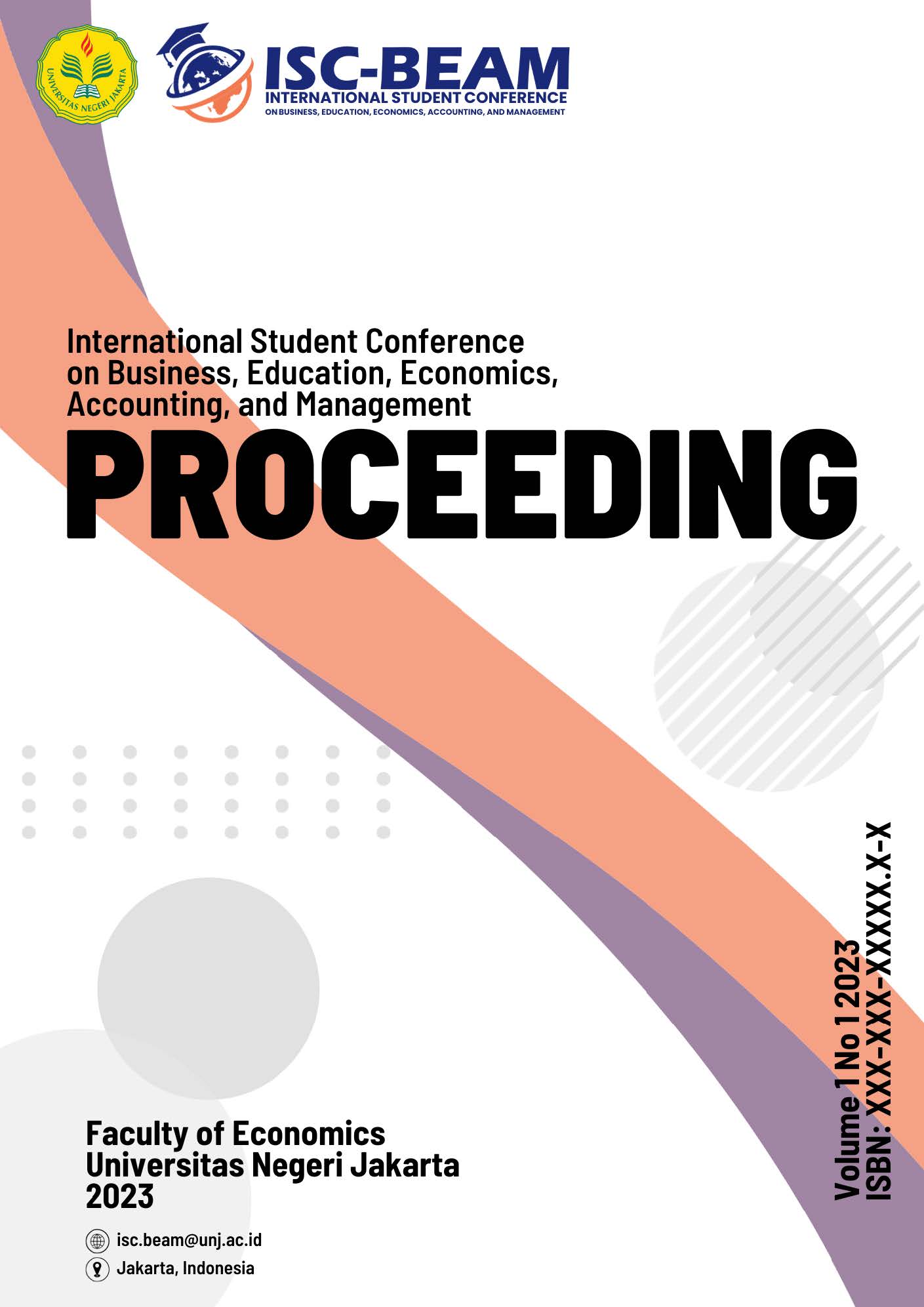Determinants of User Trust in Financial Technology Usage in Indonesia
DOI:
https://doi.org/10.21009/ISC-BEAM.011.70Keywords:
financial technology, security perception, PEOU, knowledge, user experience, trustAbstract
The objective of this research is to examine the variables that influence the level of user
confidence when utilizing Financial Technology (Fintech) in Indonesia. There are six
hypotheses tested, each of which links the variables of perceived security, knowledge, ease of
use, and user experience with user trust in Fintech. Data was collected from respondents who
have used Fintech in Indonesia and analyzed using SmartPLS 4 software. The outcome of the
research indicated that security perception significantly and positively influences ease of use,
while knowledge has a positive and significant impact on user experience, and user experience
positively and significantly affects Trust. Nonetheless, the study found no significant influence
of security perception and knowledge on trust. The implication of these results suggests that
Fintech companies operating in Indonesia should consider these factors to promote user trust
in their services.
References
Hermawan, A., Rahayu, W. P., & Arief, M. (2021, November). Analysis of Trust: A Perception onE-Commerce Transaction Among Students. In BISTIC Business Innovation Sustainability and Technology International Conference (BISTIC2021) (pp. 76-85). Atlantis Press.
Rani, M. S. B. A. (2021). Study on customer satisfaction, adoption, perception, behaviour, and Security on financial technology (fintech) services. In International Conference on Multidisciplinary Innovation and Economics (Vol. 8, p. 9th).
Zhang, J., Luximon, Y., & Song,Y. (2019). The role of consumers’ perceived security, perceived control, interface design features, and conscientiousness incontinuous use of mobile payment services. Sustainability,11(23), 6843.1006
Tahar, A., Riyadh, H. A., Sofyani,H., & Purnomo, W. E. (2020). Perceived ease of use, perceivedusefulness,perceived security and intention to use e-filing: The role of technology readiness. The Journal ofAsian Finance, Economics and Business (JAFEB),7(9), 537-547.
Denaputri,A.,&Usman,O. (2019). Effect of perceived trust, perceived security, perceived usefulness and perceived ease of use on customers’ intention to use mobile payment. Perceived Security,Perceived Usefulness and Perceived Ease of Use on Customers’ Intention to Use Mobile Payment (December16, 2019).
Putra,C. I. W., & Kurniawan, D. (2022). The effect of financial knowledge, time saving, money saving and convenience to use intention digital mobile payment apps in Bekasi City. East Asian Journal of Multidisciplinary Research, 1(11), 2727-2736.
Adiputra, I. G., Suprastha, N., & Tania, L. (2021).The influence of financial knowledge, financial attitude dan locus of control on financial behavior of E-Wallet users in Jakarta.Journal of Contemporary Issues in Business and Government Vol,27(1).
Panos, G. A., & Wilson, J. O. (2020).Financial literacy and responsible finance in the FinTech era: capabilities and challenges. The European Journal of Finance, 26(4-5),297-301.
Dewi, V., Febrian, E., Effendi, N.,& Anwar, M. (2020).Financial literacy among the millennial generation: Relationships between knowledge, skills, attitude, and behavior. Australasian Accounting, Business and FinanceJournal, 14(4),24-37.
Nguyen, T. A. N. (2022). Does financial knowledge matter in using fintech services? Evidence from an emerging economy. Sustainability, 14(9), 5083.
Ramli, Y., & Rahmawati, M. (2020).The effect of perceived ease of use and perceived usefulness that influence customer’s intention to use mobile banking application. IOSR Journal of Business and Management, 22 (6), 33-42.
Primanda, R., Setyaning, A. N.,Hidayat, A.,& Ekasasi, S. R.(2020).The role of trust on perceived usefulness and perceived ease of use toward purchase intention among Yogyakarta’s students. INOBIS: Jurnal Inovasi Bisnis dan Manajemen Indonesia,3(3), 316-326.
Usman, O., Septianti, A.,Susita, M.,& Marsofiyati, M.(2020).The effect of computer self-efficacy and subjective normon the perceived usefulness, perceived ease of use and behavioural intention to use technology. Journal of Southeast Asian Research,11.
Wilson, N., Alvita, M., & Wibisono, J. (2021).The effect of perceived ease of use and perceived security toward satisfaction and repurchase intention. Jurnal Muara Ilmu Ekonomi dan Bisnis,5(1), 145-159.
Hinderks, A., Mayo, F. J. D., Thomaschewski, J., & Escalona, M. J. (2022). Approaches to manage the user experience processin Agile software development: Asystematic literature review. Information and Software Technology,150, 106957.
Sharma, V., & Tiwari, A. K. (2021). A study on user interface and user experience designs and its tools. World Journal of Research and Review (WJRR),12(6), 41-45.
Häkkinen, V. (2022). User Experience in Online Consumer Media.ISO. (n.d.).ISO 9241-210:2010. https://www.iso.org/standard/52075.html
Samara, A., & Susanti, M.(2023). Pengaruh Kemudahan Penggunaan, Pengalaman Pengguna Dan Kepuasan Pelanggan Terhadap Loyalitas Pelanggan Pada Penggunaan Aplikasi Dompet Digital (E-Wallet) di Kalangan Mahasiswa Universitas Buddhi Dharma. Jurnal Riset Akuntansi,1(2), 249-260.
Wijaya, I., & Dorothy, R. H. (2023). The Effectof E-Satisfactionand E-TrustTowardsE-Loyalty on Shopee Customers in Bandar Lampung. International Journal of Scientific Multidisciplinary Research,1(4), 257-266.
Gultom, D. K., Arif, M., & Fahmi, M. (2020). Determinasi kepuasan pelanggan terhadap loyalitas pelanggan melalui kepercayaan. Maneggio: Jurnal Ilmiah Magister Manajemen, 3(2), 171-180.
Lailiya, N.(2020). Pengaruh brand ambassador dan kepercayaan terhadap keputusan pembelian di Tokopedia. IQTISHA Dequity jurnal Manajemen,2(2), 113-126.
Qomariah,N., &Wibowo, Y. G. (2019). Pengaruh Brand Image, Kepercayaan dan Nilai Pelanggan Terhadap Kepuasan Pelanggan Herbalife. Jurnal manajemen dan bisnis indonesia,5(2), 300-312.
Utami, M., Handayani, T., & Pusporini, P. (2019,August). Pengaruh kualitas layanan dan kepercayaan nasabah terhadap loyalitas nasabah. In Proceeding of Conference on Islamic Management, Accounting, and Economics(pp. 170-178).
Marliana, R. R. (2020).Partial Least Square-Structural Equation Modeling Pada Hubungan Antara Tingkat Kepuasan Mahasiswa dan Kualitas Google Classroom Berdasarkan Metode Webqual 4.0. Jurnal Matematika, Statistika Dan Komputasi, 16(2), 174-186.
Chua, Y. P. (2022). A step-by-step guide PLS-SEM data analysis using Smart PLS4. (NoTitle).
Karo-Karo, R. (2022). Metode Kuantitatif Untuk Manajemen.
Hutasuhut, D. I. G., Asbari, H. A., Ramadhani, J., Makito, S., & Lubis, I. (2023). Analisa Keamanan Informasi Pengguna Instander dengan Metode Analisis dan Metode Kuantitatif. Unes Journal of Information System, 8(1), 028-033.
Elsa, F. E (2019). Analisis Keterkaitan Store Image, Customer Satisfaction dan Repurchase Intention (Survei pada Pelanggan SJS Plaza) (Doctoral dissertation, Universitas Andalas).






